JVC RC-BF10B Manual
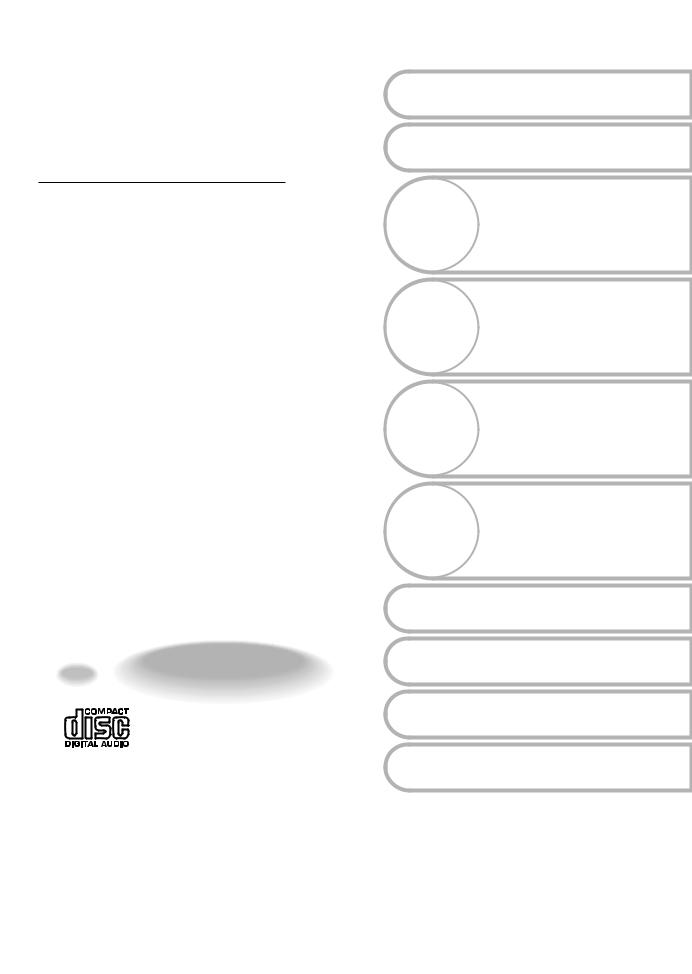
|
Introduction |
CD PORTABLE SYSTEM |
Preparation |
|
|
RC-BF10 |
Listening to CDs |
Listening to
Cassette Tapes
Listening to
Radio Broadcasts
Hearing Aid
Functions
PUSH
Convenient Functions
Recording Sound
Troubleshooting
Reference
INSTRUCTIONS
LVT1245-002A [B]
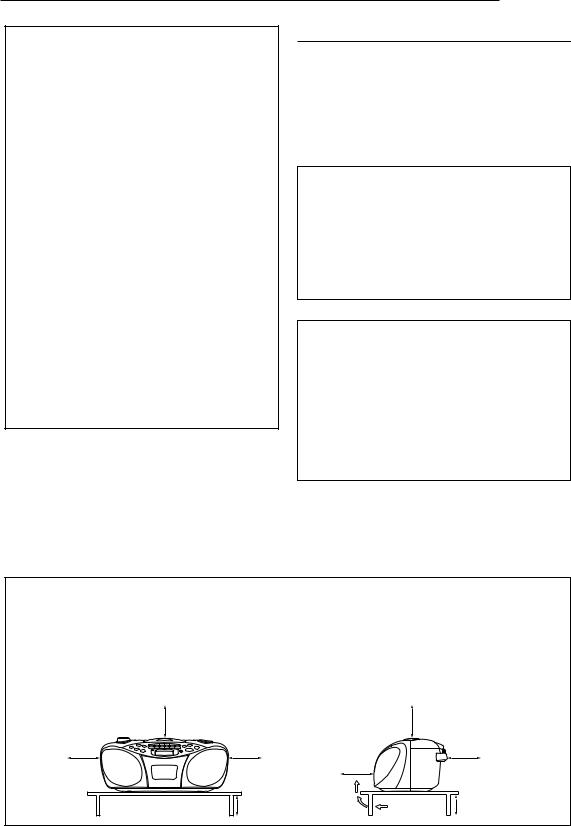
Warnings, Cautions and Others
IMPORTANT for the U.K.
DO NOT cut off the mains plug from this equipment. If the plug fitted is not suitable for the power points in your home or the cable is too short to reach a power point, then obtain an appropriate safety approved extension lead or consult your dealer.
BE SURE to replace the fuse only with an identical approved type, as originally fitted.
If nonetheless the mains plug is cut off ensure to remove the fuse and dispose of the plug immediately, to avoid a possible shock hazard by inadvertent connection to the mains supply.
If this product is not supplied fitted with a mains plug then follow the instructions given below:
IMPORTANT:
DO NOT make any connection to the terminal which is marked with the letter E or by the safety earth symbol or coloured green or green-and-yellow.
The wires in the mains lead on this product are coloured in accordance with the following code:
Blue : Neutral
Brown : Live
As these colours may not correspond with the coloured markings identifying the terminals in your plug proceed as follows:
The wire which is coloured blue must be connected to the terminal which is marked with the letter N or coloured black.
The wire which is coloured brown must be connected to the terminal which is marked with the letter L or coloured red.
IF IN DOUBT - CONSULT A COMPETENT ELECTRICIAN.
Caution –– STANDBY/ON 
 button!
button!
Disconnect the mains plug to shut the power off completely. The STANDBY/ON 
 button in any position does not disconnect the mains line.
button in any position does not disconnect the mains line.
The power can be remote controlled.
CAUTION
To reduce the risk of electrical shocks, fire, etc.:
1.Do not remove screws, covers or cabinet.
2.Do not expose this appliance to rain or moisture.
IMPORTANT FOR LASER PRODUCTS
1.CLASS 1 LASER PRODUCT
2.CAUTION: Do not open the top cover. There are no user serviceable parts inside the unit; leave all servicing to qualified service personnel.
3.CAUTION: Visible and invisible laser radiation when open and interlock failed or defeated. Avoid direct exposure to beam.
4.REPRODUCTION OF LABEL: CAUTION LABEL, PLACED INSIDE THE UNIT.
CAUTION - INVISIBLE LASER RADIATION WHEN OPEN AND INTERLOCKS DEFEATED. AVOID EXPOSURE TO BEAM.
VORSICHT ! UNSICHTBARE LASERSTRAHLUNG TRITT AUS, WENN DECKEL GEÖFFNET UND WENN SICHERHEITSVERRIEGELUNG ÜBERBRÜCKT IST. NICHT DEM STRAHL AUSSETZEN!
VARNING - OSYNLIG LASERSTRÅLNING NÄR DENNA DEL ÄR ÖPPNAD OCH SPÄRR ÄR URKOPPLAD STRÅLEN ÄR FARLIG.
ADVARSEL - USYNLIG LASERSTRÅLING VED ÅBNING NÅR SIKKERHEDSAFBRYDERE ER UDE AF FUNKTION. UNDGÅ UDSÆTTELSE FOR STRÅLING.
CAUTION
•Do not block the ventilation openings or holes.
(If the ventilation openings or holes are blocked by a newspaper or cloth, etc., the heat may not be able to get out.)
•Do not place any naked flame sources, such as lighted candles, on the apparatus.
•When discarding batteries, environmental problems must be considered and local rules or laws governing the disposal of these batteries must be followed strictly.
•Do not expose this apparatus to rain, moisture, drippimg or splashing and that no objects filled with liquids, such as vases, shall be placed on the apparatus.
Caution: Proper Ventilation
To avoid risk of electric shock and fire, and to prevent damage, locate the apparatus as follows:
1Front:
No obstructions and open spacing.
2Sides/ Top/ Back:
No obstructions should be placed in the areas shown by the dimensions below.
3Bottom:
Place on the level surface. Maintain an adequate air path for ventilation by placing on a stand with a height of 10 cm or more.
Front view |
15 cm |
Side view |
|
|
15 cm |
15 cm |
15 cm |
15 cm |
|
|
15 cm |
|
10 cm |
10 cm |
G-1

SAFETY INSTRUCTIONS
“SOME DOS AND DON'TS ON THE SAFE USE OF EQUIPMENT”
This equipment has been designed and manufactured to meet international safety standards but, like any electrical equipment, care must be taken if you are to obtain the best results and safety is to be assured.
Do read the operating instructions before you attempt to use the equipment.
Do ensure that all electrical connections (including the mains plug, extension leads and interconnections between pieces of equipment) are properly made and in accordance with the manufacturer's instructions. Switch off and withdraw the mains plug when making or changing connections.
Do consult your dealer if you are ever in doubt about the installation, operation or safety of your equipment. Do be careful with glass panels or doors on equipment.
DON'T continue to operate the equipment if you are in any doubt about it working normally, or if it is damaged in any way — switch off, withdraw the mains plug and consult your dealer.
DON'T remove any fixed cover as this may expose dangerous voltages.
DON'T leave equipment switched on when it is unattended unless it is specifically stated that it is designed for unattended operation or has a standby mode.
Switch off using the switch on the equipment and make sure that your family know how to do this.
Special arrangements may need to be made for infirm or handicapped people.
DON'T use equipment such as personal stereos or radios so that you are distracted from the requirements of traffic safety. It is illegal to watch television whilst driving.
DON'T listen to headphones at high volume as such use can permanently damage your hearing.
DON'T obstruct the ventilation of the equipment, for example with curtains or soft furnishings.
Overheating will cause damage and shorten the life of the equipment.
DON'T use makeshift stands and NEVER fix legs with wood screws — to ensure complete safety always fit the manufacturer's approved stand or legs with the fixings provided according to the instructions.
DON'T allow electrical equipment to be exposed to rain or moisture.
ABOVE ALL
—NEVER let anyone, especially children, push anything into holes, slots or any other opening in the case — this could result in a fatal electlical shock.
—NEVER guess or take chances with electrical equipment of any kind — it is better to be safe than sorry!
SAFETY PRECAUTIONS
Prevention of Electric Shocks, Fire Hazards
and Damages
•Even when the unit is in standby mode, a very small current will flow. When the unit is turned on, the display window lights in orange. When the unit is in standby mode, the display window turns off. (Note, however, that the display window does not light even when the unit is turned on if the unit is operated on batteries.) To save power and for safety when not using the unit for an extended period of
time, disconnect the power cord from the household AC outlet.
•Do not handle the power cord with wet hands.
•When unplugging from the wall outlet, always grasp and pull the plug, not the power cord.
•Consult your nearest dealer when damage, disconnection, or contact failure is found with the cord.
•Do not bend the cord sharply, or pull or twist it.
•Rating label is placed on the exterior of the bottom.
•Do not modify the power cord in any manner.
•Do not remove screws to disassemble the unit and do not touch anything inside the unit to avoid accidents.
•Do not insert any metallic objects into the unit.
•Unplug the power cord when there is a possibility of lightning.
•If water gets inside the unit, unplug the power cord from the outlet and consult your dealer.
•Do not block the ventilation holes of the unit so that heat can escape.
•Do not install the unit in a badly ventilated place.
G-2

Table of Contents
Introduction |
|
Notes on Operation ..................... |
2 |
Supplied Accessories ........................ |
2 |
Hearing Aid Functions................. |
3 |
Part Names ................................. |
4 |
Main Unit (Front View) ........................ |
4 |
Main Unit (Rear View) ........................ |
5 |
Display Window ................................. |
5 |
Remote Control .................................. |
6 |
Preparation |
|
Power Source and the Remote |
|
Control ...................................... |
7 |
Turning On/Off the Main Unit .... |
11 |
Setting the Clock ....................... |
12 |
Before Listening to Sound......... |
13 |
Adjusting the Sound Volume and |
|
Quality ........................................... |
13 |
Listening to CDs................. |
15 |
Listening to Cassette Tapes ... 17 Listening to Radio Broadcasts ... 19
Hearing Aid Functions ....... |
21 |
Convenient Functions
Storing Radio Stations (Preset) .. 23
Various CD Playback Modes .... |
25 |
Repeat Playback .............................. |
25 |
Random Playback ............................ |
27 |
Introduction Playback ...................... |
29 |
Program Playback ........................... |
31 |
Recording Sound |
|
Recording Tracks from a CD ..... |
34 |
Recording a Radio Broadcast ... |
35 |
Erasing Recorded Sound |
|
(Soundless Recording) ........... |
36 |
Troubleshooting ................. |
37 |
Reference |
|
Maintenance ............................. |
38 |
About CDs................................. |
39 |
About Cassette Tapes ............... |
40 |
Specifications ............................ |
41 |
Thank you for purchasing a JVC product.
Please read all instructions carefully before operation, to ensure your complete understanding and to obtain the best possible performance from the unit.
FEATURES
1Portable system incorporating CD player
•CD functions can be operated with the remote control unit as well as on the main unit.
•8-cm CD playback capability
2Digital LCD (Liquid Crystal Display) indicates general playback status.
3Synchronized recording with CD playback
4Hyper-bass sound effect
5Hearing aid functions
1

Notes on Operation
7 Suitable Locations for the Main Unit
To minimize the need for servicing and maintain the high quality of this product, do not place the main unit in the following locations:
•In a position subject to high humidity or considerable dust
•On an uneven or unstable surface
•Near a heat source
•Near a computer, fluorescent light or other electric appliance
•In a small room with insufficient ventilation
•In a position exposed to direct sunlight
•In a position exposed to excessive cold
•In a position exposed to strong vibration
•Near a TV, amplifier or tuner
•Near a magnetic source
CAUTION
•The operating temperature of this product is 5°C to 35°C. Use in temperatures outside this range may cause a malfunction or damage the product.
7 Condensation
Under the following conditions, you may not be able to operate this product properly due to condensation formed on the lens of the main unit:
•When you have just started an air conditioner to warm your room
•When you have placed the main unit at an area with high humidity
•When you have moved the main unit from a cold place to a warm place
When condensation forms, leave the main unit turned on, wait for approximately 1 or 2 hours, and then operate the main unit.
7 Cleaning the Main Unit
When the operation panel becomes dirty, dust it with a soft dry cloth. When the operation panel is very dirty, wipe it with a cloth dampened with a small amount of a neutral detergent, and then wipe it with a soft dry cloth.
CAUTION
•Do not wipe the operation panel with thinners, benzenes or other chemical agents. Do not spray insecticides onto the operation panel. These may cause discoloration and damage to the surface.
Supplied Accessories
Make sure that the dedicated accessories below are supplied with this product.
•Remote control (1)
•Batteries for the remote control (2)
•Power cord (1)
Introduction
2

Hearing Aid Functions
When using the hearing aid functions:
You can listen to sound that has been slowed down.
You can listen to sound that has been made clearer.
You can listen to the sound once again.
This system employs digital signal correction technology to make the speaker’s voice sound clearer so that you can hear it easily.
7 Slow Function
Even rapid speech delivered by a news announcer is slowed down.
To make rapid speech easier to understand, the main unit lowers the speed at the beginning of each sentence and gradually resumes the actual speed. Use of intervals between words (blank time) produces slower but natural sound without changing the total time of each sentence.
7 Clear Function
You can easily catch sound that has been made clearer.
Aging people have trouble hearing small voices and feel discomforted by loud voices. The main unit produces clearer sound by correcting voices to a level aging people can hear easily.
7 Repeat Function
Even if you miss a word or sentence, you can play back the sound once again.
By constantly storing the sound (10 seconds maximum) to memory, the main unit can repeat portions you missed, including telephone numbers and unfamiliar words/phrases.
3
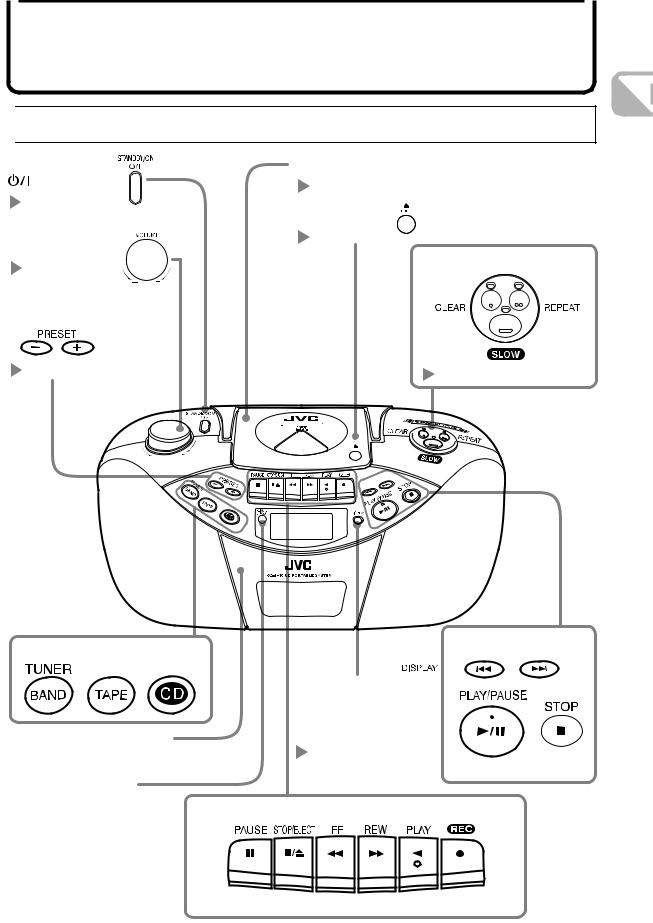
Part Names
 Main Unit (Front View)
Main Unit (Front View)
STANDBY/ON |
CD door |
|
button |
page 15 |
|
page 11 |
CD eject part |
|
|
||
Volume control |
page 15 |
|
Hearing aid buttons |
||
page 13 |
||
|
||
Preset buttons |
|
|
page 20 |
pages 21 and 22 |
|
|
Introduction
PUSH
Source select buttons
Cassette tape holder
 page 17
page 17
Remote control sensor
 page 10
page 10
CD operation buttons
Display button 
Switches the display between the regular
display and the time display. page 12
 pages 15 and 16
pages 15 and 16
Cassette tape operation buttons
 pages 17 and 18
pages 17 and 18
4
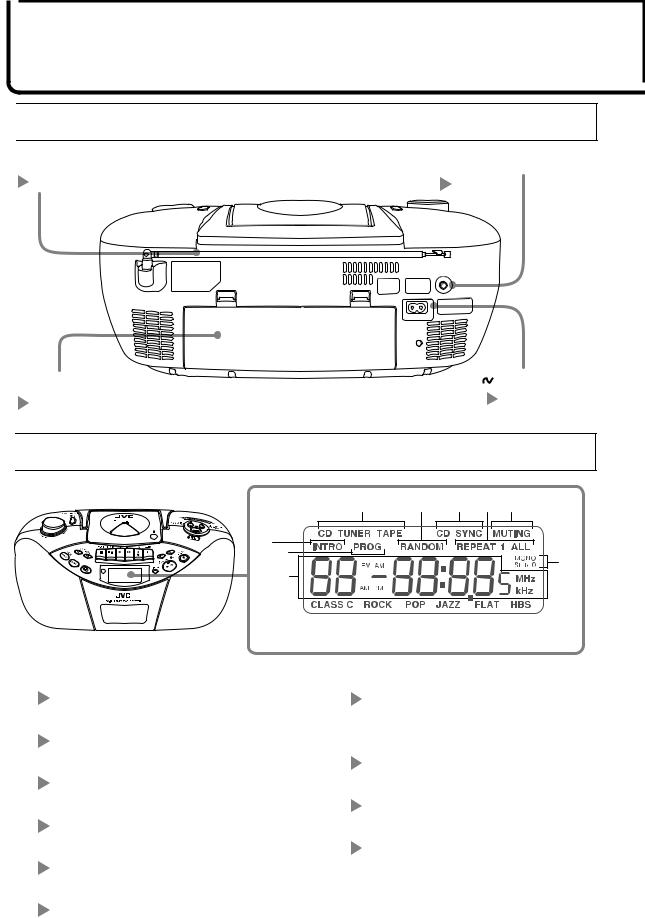
Part Names (continued)
 Main Unit (Rear View)
Main Unit (Rear View)
FM telescopic antenna |
PHONES jack |
page 20 |
page 14 |
 AC IN
AC IN
Battery cover |
AC IN socket |
page 8 |
page 7 |
 Display Window
Display Window
1 |
2 |
3 4 5 |
PUSH
67 |
q |
8 |
|
|
|
|
|
|
|
|
|
|
|
|
|
|
|
|
|
|
|
|
|
|
|
|
|
|
|
|
|
|
|
|
|
|
9 |
0 |
|
||||
1Sound source indicators |
7Program playback indicator |
||||||
pages 15, 17 and 19 |
|
page 32 |
|
|
|
|
|
2Random playback indicator |
8Main display |
|
|
|
|
||
page 28 |
9Preset equalizer indicators |
||||||
3Synchronized recording indicator |
|
page 14 |
|
|
|
|
|
page 34 |
0Hyper-bass sound indicator |
||||||
4Repeat playback indicator |
|
page 14 |
|
|
|
|
|
page 26 |
qFM band indicators |
|
|
|
|
||
5Temporary mute indicator |
|
page 20 |
|
|
|
|
|
page 13 |
|
|
|
|
|
|
|
6Introduction playback indicator |
|
|
|
|
|
|
|
page 30 |
|
|
|
|
|
|
|
5
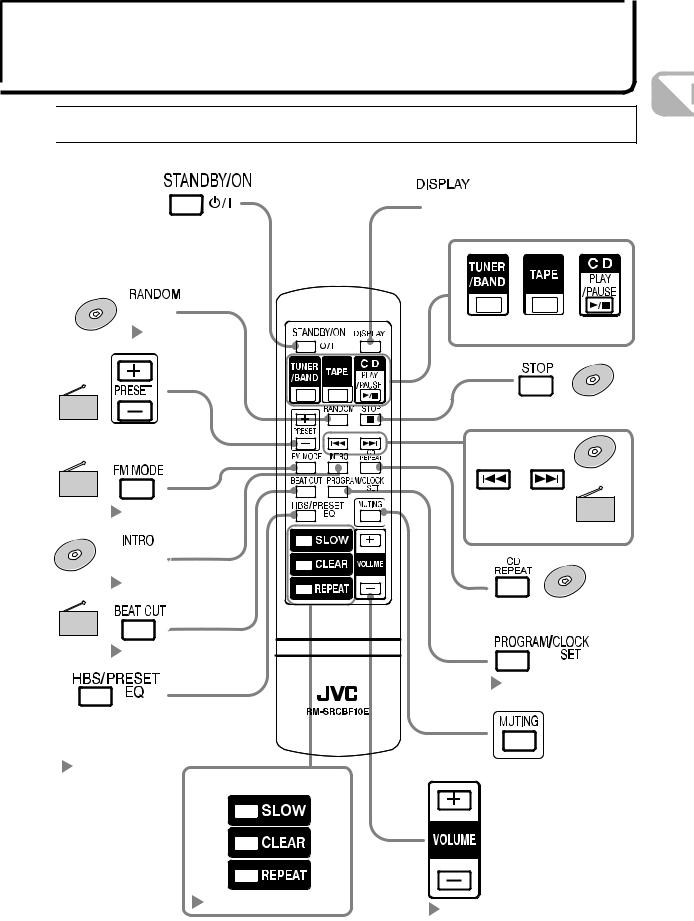
 Remote Control
Remote Control
You cannot use this button while this product is running on batteries.
 page 11
page 11
CD only  page 27
page 27
Radio only
 page 20
page 20
FM only
page 20
CD only  page 29
page 29
AM recording only
page 35
For enjoying hyper-bass sound or selecting sound quality to suit the music type.
page 14
Hearing aid buttons

 page 12
page 12
For selecting a sound source.
 CD only
CD only  page 16
page 16
CD or
Radio
 pages 16 and 19
pages 16 and 19
CD only  page 25
page 25
pages 12 and 31
 page 13
page 13
page 21 |
page 13 |
|
Introduction
6
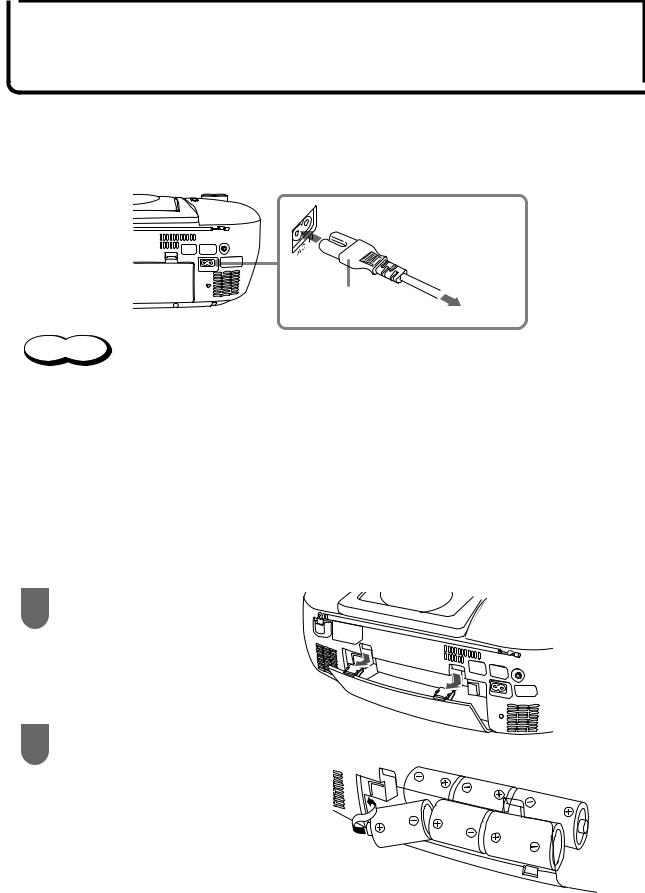
Power Source and the Remote Control
You can operate this product using either an AC outlet or batteries.
7 Connecting the Power Cord
Main unit
Supplied power cord
AC outlet
CAUTION
•Use the main unit only with the power cord provided with this product to avoid malfunction or damage to the main unit.
•Be sure to disconnect the power cord from your AC outlet when going out or when not using this product for a long period.
•Even though the main unit is turned off, while the power cord is connected, the main unit consumes a small amount of electricity.
7 Using Batteries
You cannot use batteries while the power cord is connected to the AC IN socket. When using the main unit with batteries inserted, be sure to disconnect the power cord from the AC IN socket.
1 Open the battery cover.
2 Insert six batteries.
Insert the batteries, following the diagram shown on the right to ensure that the polarities match the marks ((+) and (-)) inside the battery compartment.
|
1 |
|
3 |
6 |
5 |
|
|
|
4 |
2
R20P (SUM-1)/13D (D) (not supplied)
7
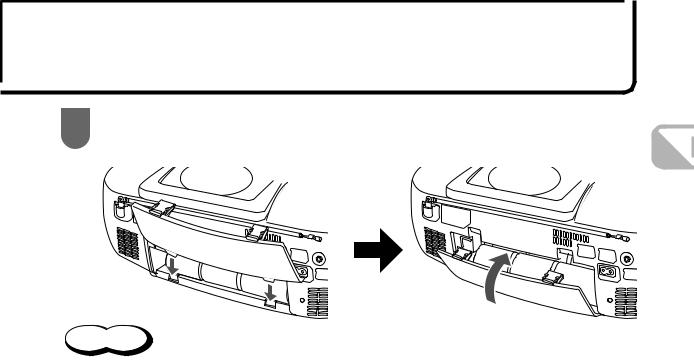
3 Replace the battery cover.
Preparation
CAUTION
•When the batteries run low, sound may become smaller or distorted, or may not be produced. In such a case, replace all of the six batteries with new batteries of the same type.
•If not using this product for a long period, take out the batteries.
•Wrap the front panel with a cushion (not supplied), steady the main unit, and then insert the batteries.
•When making important recording, use new batteries (preferably alkaline batteries with long service life) to avoid any possible failure.
•Continuous operation of this product consumes the battery power more quickly than noncontinuous operation does.
•Operation of this product in a cold place consumes the battery power more quickly than operation in a warm place.
•Incorrect use of batteries may cause leakage of chemicals from the batteries or battery explosion. Heed the following cautions.
•Do not use old batteries and new batteries at the same time. Do not use different type batteries at the same time.
•Do not attempt to charge non-rechargeable batteries.
•If chemicals from the batteries get on your skin, immediately wash them off with water. If chemicals leak onto this product, clean the product completely.
8
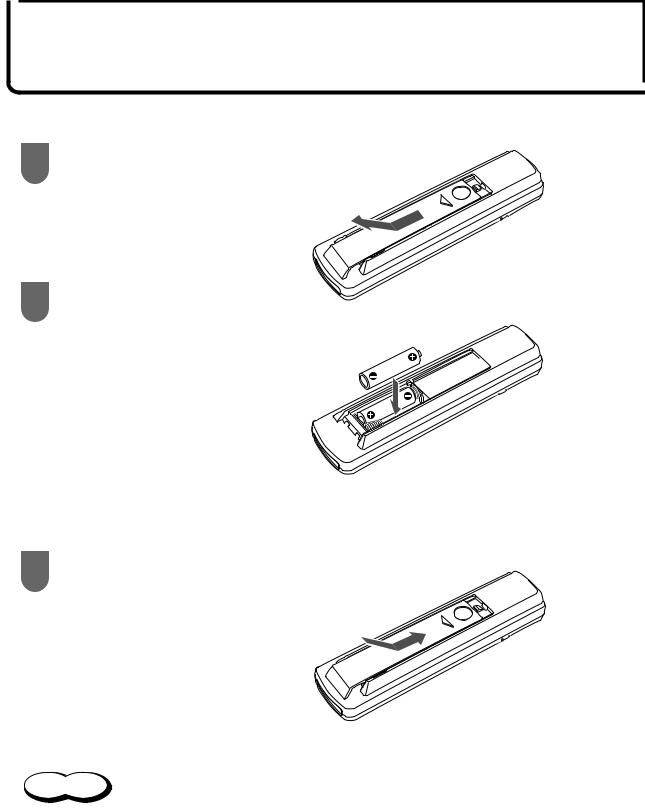
Power Source and the Remote Control (continued)
7 Inserting Batteries into the Remote Control
1 Open the battery cover.
2 Insert two batteries.
R03 (UM-4)/ 24F (AAA) (supplied)
Insert the batteries, making sure that the polarities match the marks ((+) and (-)) inside the battery compartment.
3 Attach the battery cover.
Slide the battery cover in the direction of the arrow to close it.
CAUTION
•When the effective distance decreases, the batteries have run low. In such a case, replace the two batteries with new batteries of the same type.
•Do not use old batteries and new batteries at the same time. Do not use different type batteries at the same time.
•If not using the remote control for a long period, take out the batteries.
9
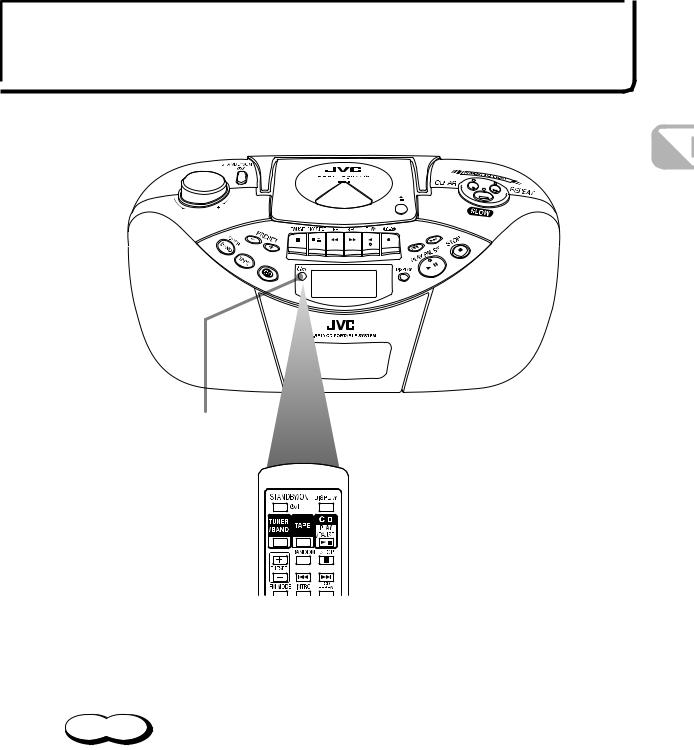
7 Remote Control Operation
PUSH
Remote control sensor (REMOTE SENSOR)
Preparation
•When operating the remote control, point it at the remote control sensor.
•The effective distance between the remote control and the remote control sensor is approximately 7 m maximum. However, the effective distance decreases when you are not directly facing the front of the main unit.
CAUTION
•Do not drop the remote control or subject it to excessive shock.
•If another radio causes noise, hold the remote control away from the radio.
•Make sure not to use the remote control under the following conditions. You may not be able to operate the remote control.
•While the remote control is exposed to direct sunlight or other intense light
•While an obstacle is in front of the remote control sensor and impedes the signal from the remote control
10
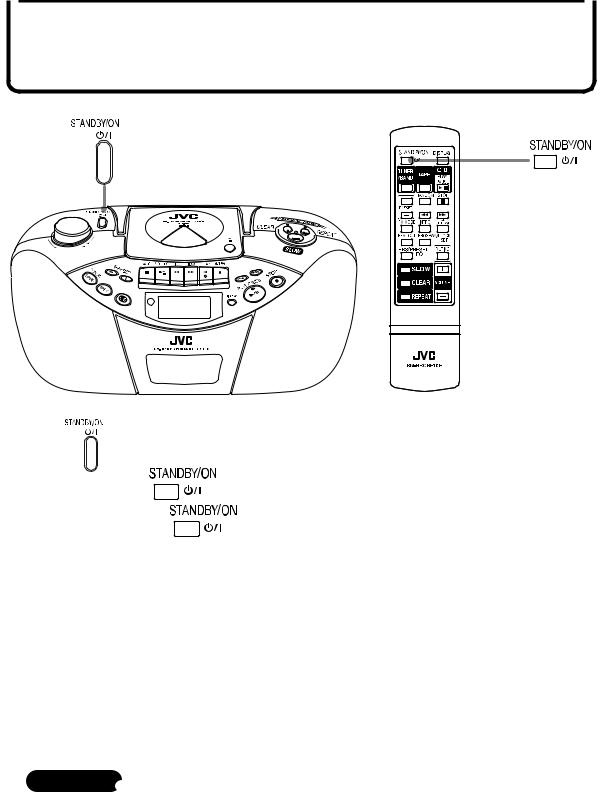
Turning On/Off the Main Unit
PUSH
Press |
on the main unit to turn on/off the main unit. |
|
• You can also use |
on the remote control to turn on/off the main unit. |
|
(You cannot operate |
while the main unit is running on batteries.) |
|
•The display window lights up when the main unit is turned on. (However, the display window does not light up even when the main unit is turned on while the main unit is running on batteries.)
•The main unit becomes ready to play back the sound source selected when the main unit was last turned off.
7 Shutting Off the Power Supply Completely
Disconnect the power cord from the AC outlet.
If the batteries are inserted in the main unit, take out the batteries.
NOTE 
•When you disconnect the power cord or if a power cut occurs, the clock is reset to
“00:00” right away ( page 12) and the preset radio stations will be canceled in a few days (
page 12) and the preset radio stations will be canceled in a few days ( pages 20, 23 and 24). The clock display will keep flashing until you set the clock again.
pages 20, 23 and 24). The clock display will keep flashing until you set the clock again.
•Take out the batteries when carrying the main unit. This prevents the power from being accidentally turned on thus, avoids wasteful battery consumption.
11
